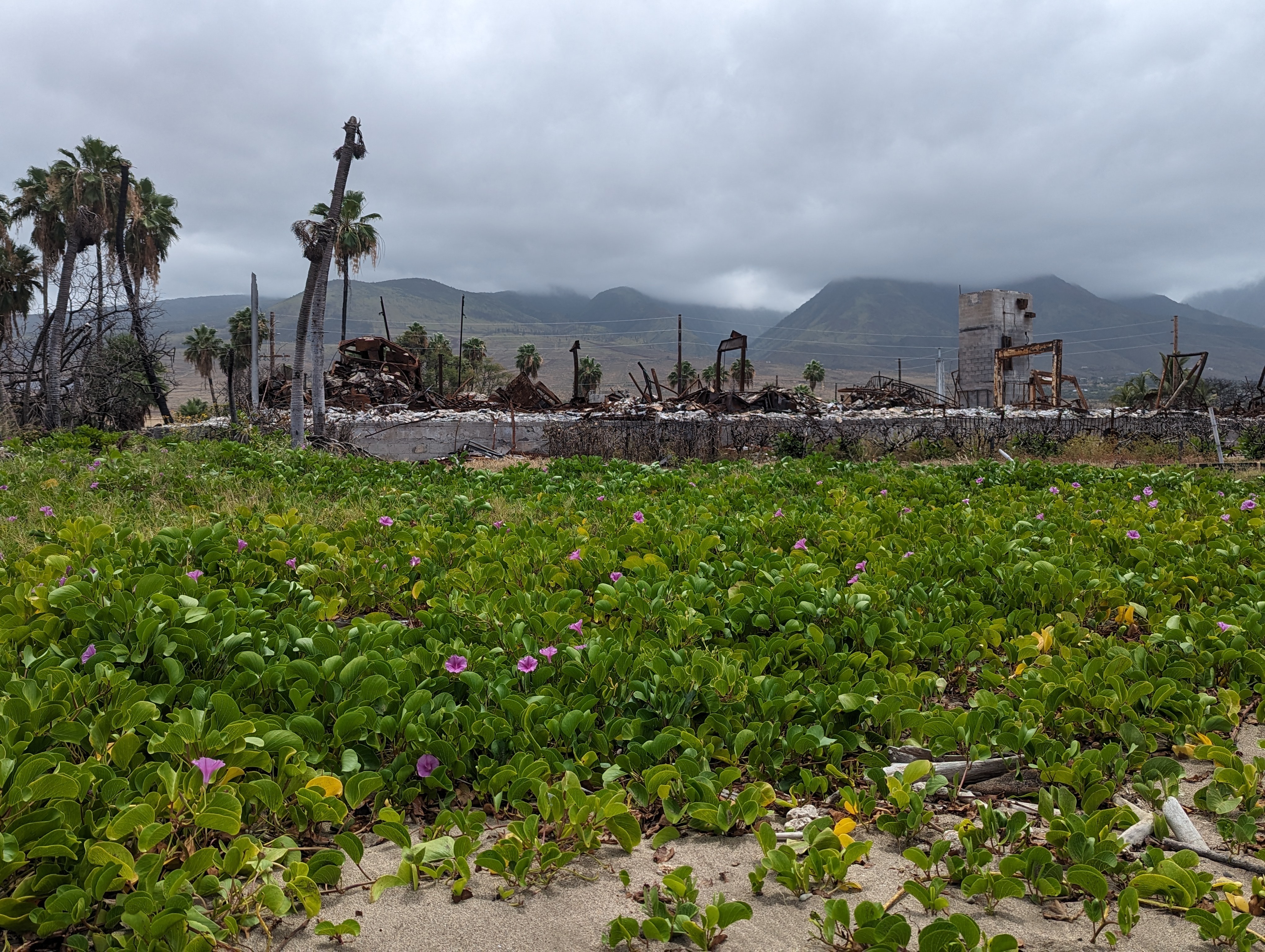
08.07.24
One Year Later: Reflections and Directions of August 8th Maui Fires Recovery Efforts
By Hanna LilleyThe August 8th fires left the Maui community forever changed. A year ago, one of the deadliest fires in U.S. history claimed the lives of 102 people, destroyed 2,200 structures and homes, and forced thousands to flee. For many here on Maui, this Thursday undoubtedly brings up traumatic memories, grief, and a reminder of the uncertainty that so many displaced Maui residents still face.
In the days, weeks, and months after the fire, Maui showed the world what it looks like for a community to really take care of each other. The grassroots activism that mobilized around Lāhainā and Upcountry Maui continues to pave the way for community-led action in the rebuild and restoration efforts and is only gaining momentum.
We are no strangers to fire on Maui, despite the fact that the native landscape evolved largely in the absence of wildfire. Due to 130 years of water diversions, industrial agriculture, and displacement of native species with invasive, fire-prone plant species, a once lush, productive landscape has become dry and at risk of wildfires.
A year after the fires in Lāhainā and Upcountry, we have transitioned from emergency response to long-term recovery - collectively planning how we can work together to rebuild and re-establish roots in a way that protects the safety and resiliency of our communities.
In Lāhainā, there is an active and growing coalition of Kānaka Maoli (Native Hawaiian) leaders and local organizations that are pushing for a return to a landscape more reminiscent of pre-colonial times. This could include a shift in priority away from Lāhainā as a hub of tourism and economic interest. The land itself is already moving in that direction with the re-emergence of wai, or water, flowing naturally, including through the sacred wetlands of Moku`ula and Mokuhinia.

Surfrider Foundation Maui Chapter Fire Response
In the first few months following the fire, the Surfrider Foundation Maui Chapter set up a post-fire water quality monitoring program to address community concerns regarding coastal water quality and recreational safety. We tested for heavy metals and fuel/oil-related contaminants (PAHs) and did not find any evidence of fire-related contamination that posed a health risk in our samples taken in the fire zone (link to results). Hawai`i Department of Health also released a statement regarding Lāhainā coastal water safety and continues post-fire water quality and sediment monitoring.
Our chapter is getting involved in long-term recovery efforts and has been working closely with Pacific Fire Exchange and the Maui Office of Recovery Natural and Cultural Resource branch. The Natural and Cultural Resource branch has been working diligently this past year to coordinate all the organizations working in fire recovery and weaving together an ‘Aloha ‘Āina’ network of community leaders, elected officials, and conservation organizations.
The U.S. Army Corps of Engineers has cleared debris of nearly all 1,437 residential and commercial properties in Lāhainā. Homeowners and businesses are returning to largely barren landscapes with a novel set of issues. The Lāhainā fire was unique from many other wildfires in that it was an urban fire. This changes the approach to landscape management as a significant part of the community restoration and revegetation efforts will occur on these private properties.
-1.jpg?width=378&height=321&name=IMG_4275%20(1)-1.jpg)
Recognizing this, our chapter has been collaborating with Pacific Fire Exchange to create a Landscaping Handbook specifically for Lāhainā residents to provide guidance on fire-resilient landscaping including suggested plant lists of climate-appropriate and fire-resilient native and non-invasive introduced species. The handbook will also include Ocean Friendly Garden principles that address stormwater runoff and plant species that have phytoremediation (the ability to clean up contamination) abilities.
What Will Happen with Shoreline Properties?
In addition to the housing crisis and water rights battle, another emerging issue of contention in Lāhainā is the future of Front Street, shoreline properties, and how the coastal zoning laws and permitting will be approached.
.jpg?width=5712&height=4284&name=IMG_4283%20(1).jpg)
Recently, Mayor Bissen approved stricter rules for shoreline management to include an updated erosion line based on predicted 3.2 foot sea level rise that establishes a no-build setback zone 40 feet from shoreline. However, for the 167 shoreline parcels that burned in Lāhainā, this does not necessarily mean that they won’t be able to rebuild, but there will be a more in-depth process and one-on-one meetings with the planning department. Please refer to the most recent Lāhainā community meeting on July 31, 2024, at the 49-minute mark for more details (link to recording).
Surfrider Foundation policy advocates for common-sense coastal setbacks based on current and historic erosion trends paired with projected sea level rise. We recognize the complex situation here in Lāhainā and are monitoring the policies as well as the West Maui communities’ desired outcomes and will advocate for development setbacks and coastal preservation where appropriate.
Stay Tuned
We will have the results of the last round of post-fire water quality monitoring in June to share very soon, so keep an eye on our website and social media. We also have an upcoming beach cleanup on August 10 from Olowalu to Ukumehame. We would love to have you join us!
